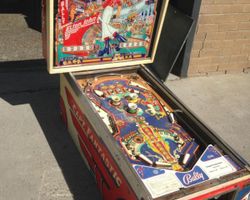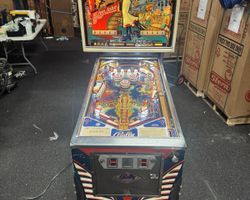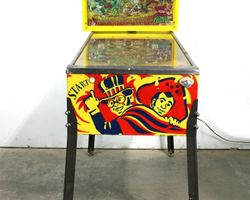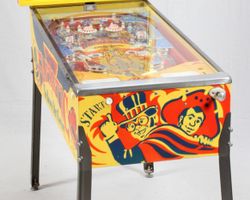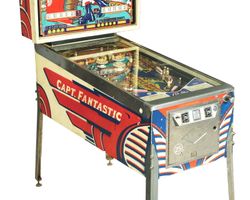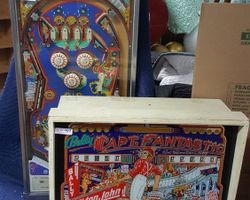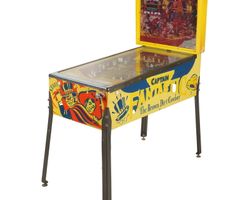Captain Fantastic & The Brown Dirt Cowboy
Released in 1977 by Bally Manufacturing Corporation, Captain Fantastic & The Brown Dirt Cowboy arrived during a pivotal period for pinball, as solid-state electronic technology began to redefine the industry. This machine stands as a direct homage to Elton John's 1975 album of the same name, a licensed theme that brought a distinct musical and celebrity presence to the flipper-driven arena. Its inspiration was drawn from the narrative and visual aesthetics of the album, translating its artistic spirit into an interactive form.
The design of Captain Fantastic & The Brown Dirt Cowboy was notably spearheaded by Alan Aldridge, a graphic artist widely recognized for his contributions to album art, including the very Elton John album that inspired this machine. Aldridge's direct involvement in the game's design meant a strong emphasis on visual coherence and thematic integration. Bally, a dominant force in the pinball market, positioned Captain Fantastic as a home model (Model Number 614-2000), differentiating it from the more robust, coin-operated machines destined for arcades. This strategic decision placed it within Bally's "Series II" home-use line, alongside machines like Galaxy Ranger and another iteration of Fireball. The production run began on January 1st, 1977, marking its place in the era of early solid-state Bally offerings. An interesting characteristic of the machine is the subtle variation in its name across different parts: the backglass proclaims "Captain Fantastic With The Brown Dirt Cowboy," the playfield reads "Captain Fantastic And The Brown Dirt Cowboy," while the cabinet simplifies it to "Captain Fantastic & The Brown Dirt Cowboy." This minor detail highlights the nuanced approach to branding and presentation.
Captain Fantastic & The Brown Dirt Cowboy distinguished itself primarily through its visual presentation and a singular gameplay quirk. The backglass, a central canvas for the machine’s thematic expression, features Elton John's likeness, rendered in the distinctive style that permeated the album's artwork. This artistic direction extends across the playfield and cabinet, creating a cohesive visual experience that captures the essence of the album. The digital display, standard for solid-state machines of this era, provided clear scoring.
A notable mechanical feature of Captain Fantastic is its unique flipper configuration: two standard flippers are present, but the lower left flipper is unusually positioned, effectively creating a "double flipper" setup in that area. This arrangement directly impacts ball control and shot execution. While it does not incorporate complex toys or elaborate mechanisms often seen in later machines, the machine's overall design prioritizes a straightforward, accessible experience, a characteristic aligned with its home model designation. The artwork, a direct translation of Alan Aldridge's celebrated style, acts as the machine's primary aesthetic draw, enhancing the overall experience through its vibrant and detailed visuals.
The playfield of Captain Fantastic & The Brown Dirt Cowboy presents a relatively simple, yet functional, layout. It features three pop bumpers centrally located, providing dynamic rebound action, alongside two primary flippers for player control. Five drop targets are strategically placed, offering specific objectives for players to aim for, often tied to bonus accumulation. Spinners, another classic pinball element, are also incorporated, rewarding continuous shots with score increments. Ball launch is controlled by a manual plunger.
The design philosophy behind this layout leans towards approachability, typical for a home model machine. The playfield is not overly complex, which allows for immediate understanding of the shot opportunities. This simplicity contributes to a relaxed flow, encouraging players to maintain ball control and repeatedly hit targets to build scores. The artwork on the playfield reinforces the theme, with vibrant illustrations that mirror the album's visual narrative. Lighting is functional, illuminating key scoring areas and contributing to the machine’s overall aesthetic appeal without resorting to elaborate light shows. The primary aesthetic strength of the machine lies in its artistic execution, creating an immersive experience through its visual storytelling.
Gameplay in Captain Fantastic & The Brown Dirt Cowboy revolves heavily around a core objective: building and collecting the bonus. The scoring system primarily rewards hitting drop targets and other playfield elements to increase a bonus meter, which is then collected when the ball drains or by hitting specific targets. A significant aspect of strategic play involves increasing the bonus multiplier, which can be achieved by hitting designated targets or completing specific sequences. The machine's progression is straightforward, focusing on maximizing bonus points rather than navigating through complex modes or multi-stage objectives.
The unique double flipper arrangement on the lower left presents a distinctive challenge. For some, this setup complicates aiming and shot consistency, demanding a different approach to ball control. Successful strategies often involve precise timing and understanding the ball's trajectory off this particular flipper. The absence of deep rule sets or narrative modes means gameplay remains focused on fundamental pinball skills: shot accuracy, flipper timing, and bonus management. Player engagement is driven by the immediate feedback of scoring and the challenge of navigating the playfield to secure high bonus totals.
Reception for Captain Fantastic & The Brown Dirt Cowboy within the pinball community has been mixed. Its strengths are almost universally attributed to its exceptional artwork, particularly the backglass, which frequently receives praise for its beauty and thematic alignment. The Elton John theme also resonates positively with fans of the artist and those who appreciate licensed properties in pinball. For some, the gameplay, while simple, provides an enjoyable and entertaining experience, reminiscent of earlier pinball eras. Many collectors value the machine for its classic appeal and the nostalgic connection it offers.
However, the machine's weaknesses are also frequently discussed. A common point of feedback is the perceived simplicity or "basic" nature of the gameplay, which some find uninspired or lacking the depth to sustain long-term engagement. The sound and audio quality, consistent with early solid-state technology, is often criticized as rudimentary. Crucially, the machine’s designation as a "home edition" is central to much of the feedback; it was designed with consumer-grade components, leading to a "light and flimsy feeling" compared to commercial arcade machines. This fundamental design choice, while suitable for its intended market, contributes to some of the critical assessments. The double flipper on the lower left is a contentious feature, with many players finding it difficult to master and detrimental to precision shots. Despite these points of contention, Captain Fantastic maintains a presence in the community due to its distinctive visual style and historical context. Its significance lies not in revolutionizing gameplay, but in its role as a notable example of early solid-state home pinball, showcasing Bally’s venture into licensed themes and the consumer market. It holds a particular place in the lineage of music-themed pinball machines, setting a precedent for incorporating popular artists and their visual identities directly into the game's design.
Sponsored Links
 Ebay Listings
Ebay Listings
 Auction Results
Auction Results
| Cost | Location | Date |
|---|---|---|
| USD $5,489 |  Florida, United States Florida, United States |
02 November, 2025 |
| USD $2,100 |  Minnesota, United States Minnesota, United States |
22 April, 2025 |
| USD $2,100 |  Minnesota, United States Minnesota, United States |
22 April, 2025 |
| USD $7,200 |  Colorado, United States Colorado, United States |
24 January, 2025 |
| USD $765 |  Arizona, United States Arizona, United States |
14 January, 2025 |
| USD $1,500 |  Indiana, United States Indiana, United States |
22 December, 2024 |
| GBP £6,000 |  Watford, United Kingdom Watford, United Kingdom |
15 December, 2024 |
| USD $2,600 |  Nevada, United States Nevada, United States |
05 December, 2024 |
| USD $5,889 |  Florida, United States Florida, United States |
04 December, 2024 |
| USD $5,000 |  Arizona, United States Arizona, United States |
27 November, 2024 |


Private Policy · Search Website · Contact Us
As an eBay Partner, we may earn a commission from qualifying purchases made through links on this site, at no additional cost to you.
All trademarks and copyrighted materials remain property of their respective owners. All other content copyright 2007 - 2025 Pinpedia.

